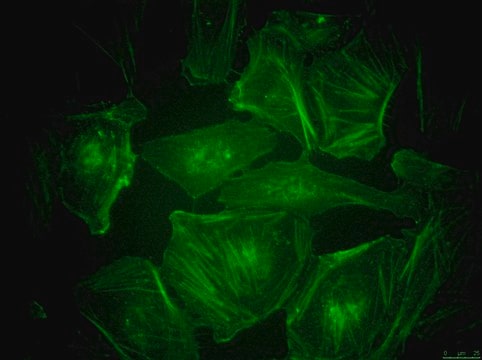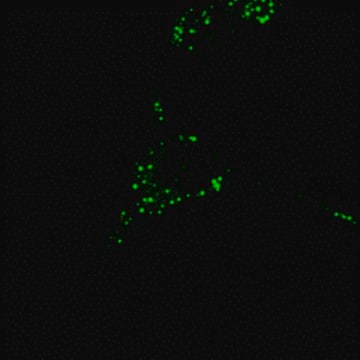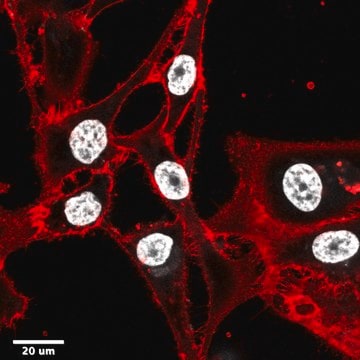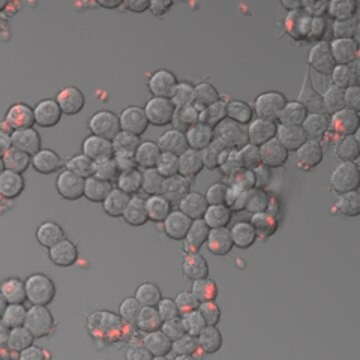SCT089
BioTracker™ rRNA Live Cell Probe
Fluorescent detection of ribosomal RNA and cell nucleoli
Synonym(s):
live cell probe, nucleoli probe, nucleolus probe, rRNA dye, rRNA probe, ribosomal RNA probe
Sign Into View Organizational & Contract Pricing
All Photos(2)
About This Item
UNSPSC Code:
12171501
NACRES:
NA.31
Recommended Products
General description
The BioTracker™rRNA live cell probe is a styryl quinolinium dye that selectively binds ribosomal RNA (rRNA) in the cytoplasm and nucleoli of mammalian cells 1. This probe is a fluorescent small molecule that demonstrates high affinity to rRNA and therefore enables imaging of the nucleolus. Due to its low cytotoxicity, it enables detection in living systems with minimal interference.1 . As imaging technologies progress, there is increased demand for reagents that can detect diverse organoids and enable observation of subcellular functions in living cells. The optimal fluorescent reagent for live cell imaging should show high specificity to target along with low cytotoxicity 2 . Because the nucleolus is a dense organoid composed of chromatin and numerous protein components, the development of fluorescent reagents for live cell nucleoli detection is even more challenging 2,3,4. BioTracker™ rRNA live cell probe is easy to use, emits light in a longer wavelength to reduce phototoxicity and facilitate multiplexing, and can enhance nucleolar imaging dynamics.
Spectral Properties:Fluorescence images obtained by λex = 570 nm and emission at 647-667 nm.
Spectral Properties:Fluorescence images obtained by λex = 570 nm and emission at 647-667 nm.
Application
Live cell imaging probefor detection of ribosomal RNA (rRNA). Can also be used in fixed cell or tissuesamples, such as with a nuclear counterstain to identify nucleoli.
Quality
Purity: ≥ 95% confirmed by HPLC. Molar Mass: 298 Da confirmed byLC-MS.
Storage and Stability
Store BioTracker™ rRNA Live CellProbe at 2-8 °C, desiccated and protected from light
Note: Centrifuge vial briefly to collect contents at bottom ofvial before opening.
Note: Centrifuge vial briefly to collect contents at bottom ofvial before opening.
Legal Information
BioTracker is a trademark of Merck KGaA, Darmstadt, Germany
Storage Class Code
11 - Combustible Solids
WGK
WGK 3
Flash Point(F)
Not applicable
Flash Point(C)
Not applicable
Certificates of Analysis (COA)
Search for Certificates of Analysis (COA) by entering the products Lot/Batch Number. Lot and Batch Numbers can be found on a product’s label following the words ‘Lot’ or ‘Batch’.
Already Own This Product?
Find documentation for the products that you have recently purchased in the Document Library.
Tae-Keun Kim et al.
Cells, 8(7) (2019-07-13)
The cell nucleus is three-dimensionally and dynamically organized by nuclear components with high molecular density, such as chromatin and nuclear bodies. The structure and functions of these components are represented by the diffusion and interaction of related factors. Recent studies
Red emissive cross-linked chitosan and their nanoparticles for imaging the nucleoli of living cells.
Ke Wang et al.
Carbohydrate polymers, 102, 699-707 (2014-02-11)
Biocompatible glutaraldehyde-cross-linked chitosan with new red fluorescence were prepared for the first time and were shaped into nanoparticles via inverse-microemulsion method. They could luminesce at ca. 670 nm either as powders and nanoparticles or in real and gelling solutions or
Applying styryl quinolinium fluorescent probes for imaging of ribosomal RNA in living cells
Abed Saadya, Eli Varonb, Avi Jacobb, Yaron Shav-Talb, Bilha Fischera
Dyes and Pigments, 174 (2020)
Robert M Martin et al.
Histochemistry and cell biology, 127(3), 243-251 (2007-01-06)
In the recent molecular and cell biological research, there is an increasing need for labeling of subcellular structures in living cells. Here, we present the use of a fluorescently labeled cell penetrating peptide for fast labeling of nucleoli in living
Our team of scientists has experience in all areas of research including Life Science, Material Science, Chemical Synthesis, Chromatography, Analytical and many others.
Contact Technical Service






